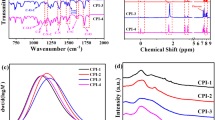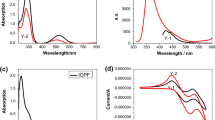Abstract
Acryl chemistry provides the convenience of manufacturing various functional polymers because of a lot of commercially available monomers and a facile polymerization method. In this study, novel fluorinated acrylic polymers with a benzotriazole pendant were successfully synthesized via radical polymerization. These polymers exhibited considerably high thermal stabilities and low surface energies because of fluorinated alkyl groups along with excellent optical properties owing to the presence of fluorinated alkyl groups and the intense UV absorption of the benzotriazole moiety (i.e., relatively low refractive indices), illustrating perfect UV-blocking performances of up to approximately 380 nm. Moreover, polymer-coated PET films exhibited high visible-light transmittance due to the antireflection in the interface between the PET substrate and the polymer film. The present benzotriazole-containing fluorinated acrylic polymers are expected to be used as UV-blocking organic coating materials, especially for organic solar cell applications.
Graphical abstract








Similar content being viewed by others
References
Chen H, Hou J, Zhang S, Liang Y, Yang G, Yang Y, Yu L, Wu Y, Li G (2009) Polymer solar cells with enhanced open-circuit voltage and efficiency. Nat Photon 3:649–653
Zhou Y, Zhang F, Tvingstedt K, Barrau S, Li F, Tian W, Inganäs O (2008) Investigation on polymer anode design for flexible polymer solar cells. Appl Phys Lett 92:233308
Hong L, Yao H, Wu Z, Cui Y, Zhang T, Xu Y, Yu R, Liao Q, Gao B, Xian K, Woo H, Ge Z, Hou J (2019) Eco-compatible solvent-processed organic photovoltaic cells with over 16% efficiency. Adv Mater 31:1903441
Kerbs FC, Tromholt T, Jørgensen M (2010) Upscaling of polymer solar cell fabrication using full roll-to-roll processing. Nanoscale 2:873–886
Norrman K, Madsen MV, Gevorgyan SA, Krebs FC (2010) Degradation patterns in water and oxygen of an inverted polymer solar cell. J Am Chem Soc 132:16883–16892
Rivaton A, Chambon S, Manceau M, Gardette JL, Lemaitre N, Guillerez S (2010) Light-induced degradation of the active layer of polymer-based solar cells. Polym Degrad Stab 95:278–284
Fuse Y, Ide Y, Ogawa M (2010) Hybridization of epoxy resin with a layered titanate and UV light durability and controlled refractive index of the resulting nanocomposite. Polym Chem 1:849–853
Wang RH, Xin JH, Tao XM (2005) UV-blocking property of dumbbell-shaped ZnO crystallites on cotton fabrics. Inorg Chem 44:3926–3930
Masui T, Yamamoto M, Sakata T, Mori H, Adachi G (2000) Synthesis of BN-coated CeCO2 fine powder as a new UV blocking material. J Mater Chem 10:353–357
Bojinov VB, Simeonov DB (2006) Synthesis of novel bifunctional polymer stabilizers—a combination of HALS and UV absorber. J Photochem Photobiol A Chem 180:205–212
Goldshtein J, Margel S (2009) Synthsis and characterization of new UV absorbing microspheres of narrow size distribution by dispersion polymerization of 2-(2′-hydroxy-5′-methacryloxyethylphenyl)-2H-benzotriazole. Polymer 50:3422–3430
Carlson DP, Scmiegel W (2000) “Fluoropolymers, organic”. Ullmann’s encyclopedia of industrial chemistry, p 3
Saxena P, Shukla P (2021) A comprehensive review on fundamental properties and applications of poly(vinylidene fluoride) (PVDF). Adv Compos Hybrid Mater 4:8–26
Saxena P, Shukla P (2021) A comparative analysis of the basic properties and applications of poly(vinylidene fluoride) (PVDF) and poly(methyl methacrylate) (PMMA). Polym Bull. https://doi.org/10.1007/s00289-021-03790-y
Dhanumalayan E, Joshi GM (2018) Performance properties and applications of polytetrafluoroethylene (PTFE)—a review. Adv Compos Hybrid Mater 1:247–268
Saunders KJ (1988) Acrylic polymers in organic polymer chemistry. Springer, Dordrecht, pp 125–148
Brydson JA (2013) In: Acryl plastics. Plastics materials. Elsevier, pp 383‒409
Kaino T, Katayama Y (1989) Polymers for optoelectronics. Polym Eng Sci 29:1209–1214
Yeniay A, Gao R, Takayama K, Gao R, Garito AF (2004) Ultra-low-loss polymer waveguides. J Lightwave Technol 22:154–158
Vasilopoulou M, Douvas AM, Palilis LC, Bayiati P, Alexandropoulos D, Stathopoulos NA, Argitis P (2009) Highly transparent partially fluorinated methacrylate polymers for optical waveguides. Microelectron Eng 86:1142–1145
Groh W (1988) Overtone absorption in macromolecules for polymer optical fibers. Macromol Chem 189:2861–2874
Takezawa Y, Taketani N, Tanno S, Ohara S (1992) Light absorption due to higher harmonics of molecular vibrations in transparent amorphous polymers for plastic optical fibers. J Polym Sci Part B Polym Phys 30:879–885
Tadmor R (2004) Line energy and the relation between advancing, receding, and young contact angles. Langmuir 20:7659–7664
Rudawska A, Jacniacka E (2009) Analysis for determining surface free energy uncertainty by the Owen–Wendt method. Int J Adhes Adhes 29:451–457
Lemal DM (2004) Perspective on fluorocarbon chemistry. J Org Chem 69:1–11
Sawada H, Sasaki A, Sasazawa K, Kawase T, Ueno K, Hamazaki K (2005) Dispersion of gold nanoparticles above the poly(methyl methacrylate) surface by the use of fluoroalkyl end-capped oligomeric aggregates. Colloid Polym Sci 282:583–586
Sawada H, Furukuwa R, Sasazawa K, Mugigawa M, Ohnishi K (2007) Preparation of novel cross-linked fluoroalkyl end-capped adamantane cooligomer/copper nanocomposites. Eur Polym J 43:3258–3263
Pauling L (1932) The nature of the chemical bond. IV. The energy of single bonds and the relative electronegativity of atoms. J Am Chem Soc 54:3570–3582
Kharitonov AP, Taege R, Ferrier G, Piven NP (2005) The kinetics and mechanism of the direct fluorination of polyethylenes. Surf Coat Int B Coat Trans 88:201–212
Kjaergaard HG, Howard DL, Schofield DP, Robinson TW, Ishiuchi S, Fujii M (2002) OH- and CH-stretching overtone spectra of catechol. J Phys Chem A 106:258–266
Rong Z, Henry BR, Robinson TW, Kjaergaard HG (2005) Absolute intensities of CH stretching overtones in alkenes. J Phys Chem A 109:1033–1041
Rueda D, Boyarkin OV, Rizzo TR, Chirokolava A, Perry DS (2005) Vibrational overtone spectroscopy of jet-cooled methanol from 5000 to 14000 cm−1. J Chem Phys 122:044314
Lei H, He D, Guo Y, Tang Y, Huang H (2018) Synthesis and characterization of UV-absorbing fluorine-silicone acrylic resin polymer. Appl Surf Sci 442:71–77
Acknowledgements
This work was supported by the Basic Science Research Program of National Research Foundation of Korea (NRF) grants funded by the Korea government (MEST) (2020R1A2C1010980).
Author information
Authors and Affiliations
Corresponding author
Ethics declarations
Conflict of interests
The authors declare no conflicts of interest regarding the publication of this paper.
Additional information
Publisher's Note
Springer Nature remains neutral with regard to jurisdictional claims in published maps and institutional affiliations.
Rights and permissions
About this article
Cite this article
Han, D.C., Kim, H. & Kwak, G. Benzotriazole-containing fluorinated acrylic polymer coatings with high thermal stability, low surface energy, high visible-light transparency, and UV-blocking performance. Polym. Bull. 80, 5641–5654 (2023). https://doi.org/10.1007/s00289-022-04340-w
Received:
Revised:
Accepted:
Published:
Issue Date:
DOI: https://doi.org/10.1007/s00289-022-04340-w




